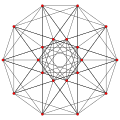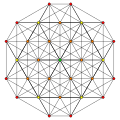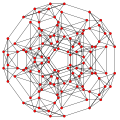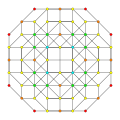| # | Coxeter plane graphs | Coxeter-Dynkin diagram
Schläfli symbol
Name |
|---|
| [6] | [5] | [4] | [3] |
|---|
| A5 | A4 | A3 | A2 |
|---|
| 1 |  |  |  |  |         
{3,3,3,3}
5-simplex (hix) |
|---|
| 2 |  |  |  |  |         
t1{3,3,3,3} or r{3,3,3,3}
Rectified 5-simplex (rix) |
|---|
| 3 |  |  |  |  |         
t2{3,3,3,3} or 2r{3,3,3,3}
Birectified 5-simplex (dot) |
|---|
| 4 |  |  |  |  |         
t0,1{3,3,3,3} or t{3,3,3,3}
Truncated 5-simplex (tix) |
|---|
| 5 |  |  |  |  |         
t1,2{3,3,3,3} or 2t{3,3,3,3}
Bitruncated 5-simplex (bittix) |
|---|
| 6 |  |  |  |  |         
t0,2{3,3,3,3} or rr{3,3,3,3}
Cantellated 5-simplex (sarx) |
|---|
| 7 |  |  |  |  |         
t1,3{3,3,3,3} or 2rr{3,3,3,3}
Bicantellated 5-simplex (sibrid) |
|---|
| 8 |  |  |  |  |         
t0,3{3,3,3,3}
Runcinated 5-simplex (spix) |
|---|
| 9 |  |  |  |  |         
t0,4{3,3,3,3} or 2r2r{3,3,3,3}
Stericated 5-simplex (scad) |
|---|
| 10 |  |  |  |  |         
t0,1,2{3,3,3,3} or tr{3,3,3,3}
Cantitruncated 5-simplex (garx) |
|---|
| 11 |  |  |  |  |         
t1,2,3{3,3,3,3} or 2tr{3,3,3,3}
Bicantitruncated 5-simplex (gibrid) |
|---|
| 12 |  |  |  |  |         
t0,1,3{3,3,3,3}
Runcitruncated 5-simplex (pattix) |
|---|
| 13 |  |  |  |  |         
t0,2,3{3,3,3,3}
Runcicantellated 5-simplex (pirx) |
|---|
| 14 |  |  |  |  |         
t0,1,4{3,3,3,3}
Steritruncated 5-simplex (cappix) |
|---|
| 15 |  |  |  |  |         
t0,2,4{3,3,3,3}
Stericantellated 5-simplex (card) |
|---|
| 16 |  |  |  |  |         
t0,1,2,3{3,3,3,3}
Runcicantitruncated 5-simplex (gippix) |
|---|
| 17 |  |  |  |  |         
t0,1,2,4{3,3,3,3}
Stericantitruncated 5-simplex (cograx) |
|---|
| 18 |  |  |  |  |         
t0,1,3,4{3,3,3,3}
Steriruncitruncated 5-simplex (captid) |
|---|
| 19 |  |  |  |  |         
t0,1,2,3,4{3,3,3,3}
Omnitruncated 5-simplex (gocad) |
|---|












































































